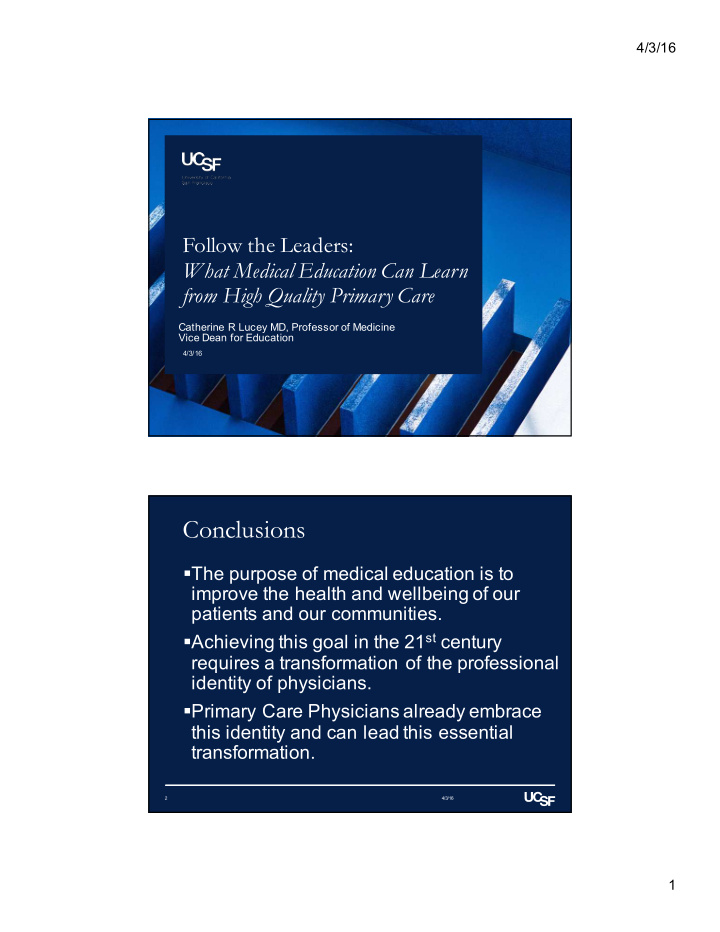



4/3/16 Follow the Leaders: What Medical Education Can Learn from High Quality Primary Care Catherine R Lucey MD, Professor of Medicine Vice Dean for Education 4/3/16 Conclusions § The purpose of medical education is to improve the health and wellbeing of our patients and our communities. § Achieving this goal in the 21 st century requires a transformation of the professional identity of physicians. § Primary Care Physicians already embrace this identity and can lead this essential transformation. 2 4/3/16 1
4/3/16 20 th Century Science: Physics 3 20 th Century Medicine : Linear Correlation between Causation, Disease, Treatment “Mono-causal, Reductionist, Biomedical Exposure Disease Diagnosis Treatment Un-disease Pauli HG. Medical Education, Research, And Scientific Thinking in the 21 st Century. Education for Health , Vol. 13, No. 1, 2000, 15–25 4 2
4/3/16 20 th Century Medical Education: The Teaching Paradigm 5 20 th Century Physician Role: Omnipotent Manager 6 3
4/3/16 Success! Nable E, Braunwald E. NEJM 2012 7 Success! 8 4
4/3/16 And Challenges 9 21 st Century Science: Systems Biology 10 5
4/3/16 21 st Century Medicine: Complexity http://www.nature.com/clpt/journal/v93/n1/images/clpt2012199f1.gif 11 21 st Century Medical Education: The Learning Paradigm 12 6
4/3/16 21 st Century Physician Role: Collaborative Complexity Leader 13 Core elements of Complexity Leadership § Focuses on Purpose § Uncovers communal vision & contrasts with reality § Catalyzes knowledge sharing, experimentation and innovation § Adapts to changing contexts and forces § Facilitates emergent leadership & relationships § Harnesses structure and incentives to support innovation Uhl-Bien M et al. Complexity Leadership Theory. The Leadership Quarterly 18 :4 (August 2007), pp. 298-318 14 7
4/3/16 Primary Care Physicians Are Natural Complexity Leaders 15 Purpose Driven Vision and Values § Patient Centered Care § Respectful, Comprehensive, Coordinated, High Quality, Safe, Dignified § Patient Centered Outcomes § Compatible with Patient Goals § Focus on Function, Quality of Life, and Relief of Suffering § Patients Supported by Interprofessional Teams JAGS 53:S245–S256, 2005 16 8
4/3/16 Leadership Strategies and Values § Advance and Disseminate Knowledge § Mobilize Expertise from Entire Interprofessional Team § Synthesize Shared Knowledge to Innovate § Work in & continuously improve systems § Adapt to individual patients as well as changing environment 17 The Success of Complexity Leadership in Primary Care Practice § Innovating in Care Delivery § Posing new questions about medical decisions § Challenging dominant paradigms of disease and disability § Developing others § Broadening educational venues § Re-conceptualizing Wellness to Include Healthy Aging 18 9
4/3/16 A Continued Challenge Encouraging physicians to pursue Primary Care as a career. 19 LEADERS ASK BIGGER QUESTIONS 20 10
4/3/16 LEADERS CLARIFY THE VISION 21 That Vision Must Be.. Authentic Patient Centered Care… 22 11
4/3/16 A Age Mature and Develop Reproduce ….Across the Human Lifespan..... 23 …..Provided by Collaboratively Expert Physicians and Teams 24 12
4/3/16 LEADERS CONTRAST CURRENT REALITY WITH ASPIRATIONAL GOAL 25 20 th Century Physician Competencies Clinical Skills Biomedical and Behavioral Sciences 13
4/3/16 • Understanding and • Diagnosing, treating improving patient and supporting experience, patients population health • Dedication, empathy , and clinical systems commitment Systems Direct Patient Improvement Care Skills Skills 21 st Century Physician Competencies EMERGING ENDURING Biomedical and Implementation Behavioral Sciences Sciences • Foundational • Foundational knowledge to knowledge to optimize care understand and delivery advance disease and therapeutics LEADERS BUILD A GUIDING COALITION AROUND COMMON PURPOSE 28 14
4/3/16 Primary Care Physicians Clinician Educators Physician Experts in Population and Public Health Physician Scientists • Precision Medicine Common Purpose: Healthy People 29 LEADERS ALIGN EDUCATIONAL STRATEGIES WITH VALUES 30 15
4/3/16 Core Values § Patient Centeredness § Interprofessional teamwork § Continuous monitoring and improvement of systems of care § Synthesizing Information into new knowledge § Eliminating Inequities and Achieving Social Justice 31 SO WHAT DOES THIS MEAN TO THOSE OF YOU WHO ARE HELPING TO EDUCATE THE NEXT GENERATION? 32 16
4/3/16 Transactional Understanding Patient Goals Conversations Mono- Working in professional Interprofessional Teams work Enduring Emerging Systems Career Membership and Exploration Accountability Mastery of Critical Problem Solving Facts Change in Sequence & Priorities of Med Ed 33 Focus on Authentic Work in Communities of Practice Patients Learner à Experienced à Experts Wenger, Etienne (1998) ‘Communities of Practice. Learning as a social system’, Systems Thinker , 17
4/3/16 Prioritize Relationships 35 Emphasize Deep Thinking Rather than Fact Finding 36 18
4/3/16 Help us work to Make Medicine more Diverse and Inclusive 37 Conclusions § The purpose of medical education is to improve the health and wellbeing of our patients and our communities. § Achieving this goal in the 21 st century requires a transformation of the professional identity of physicians. § Primary Care Physicians already embrace this identity and can lead this essential transformation. 38 19
4/3/16 UCSF is driven by the idea that great breakthroughs are achieved when the best research, the best education and the best patient care converge. 20
Recommend
More recommend